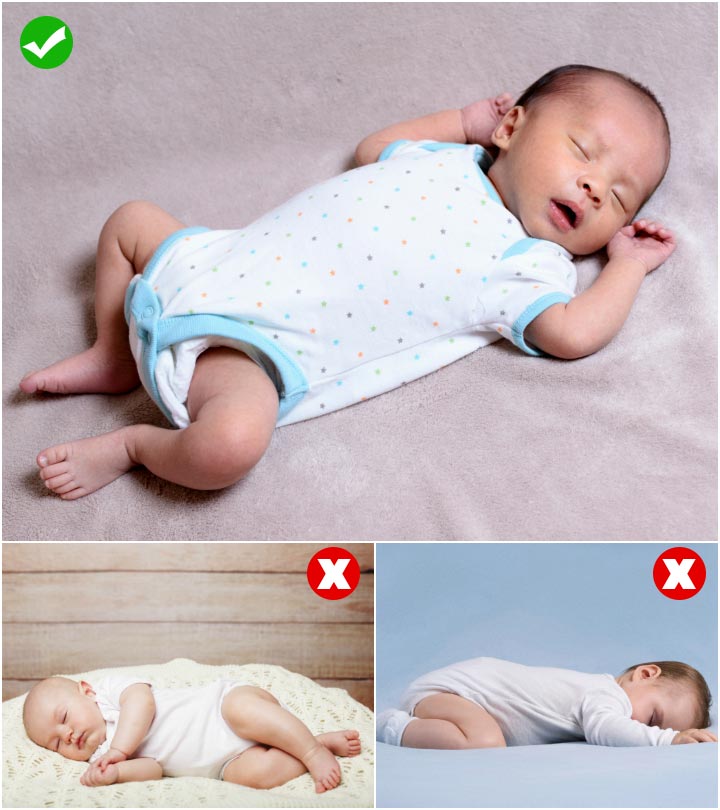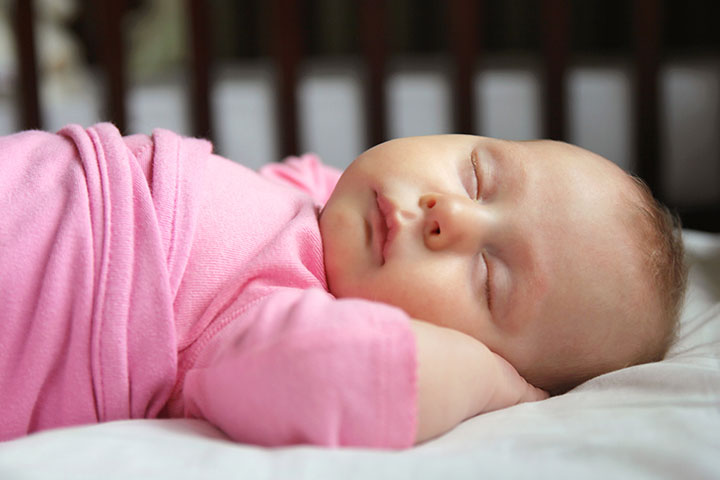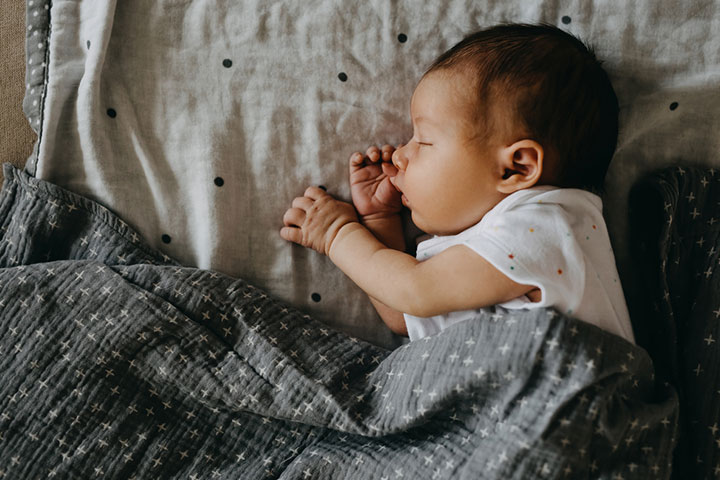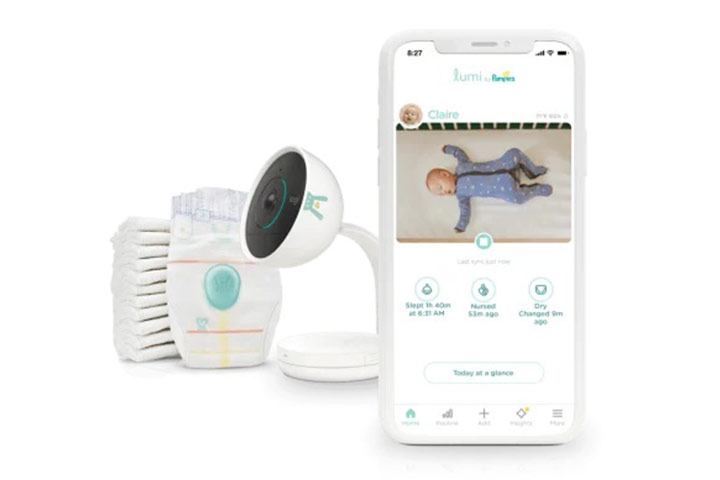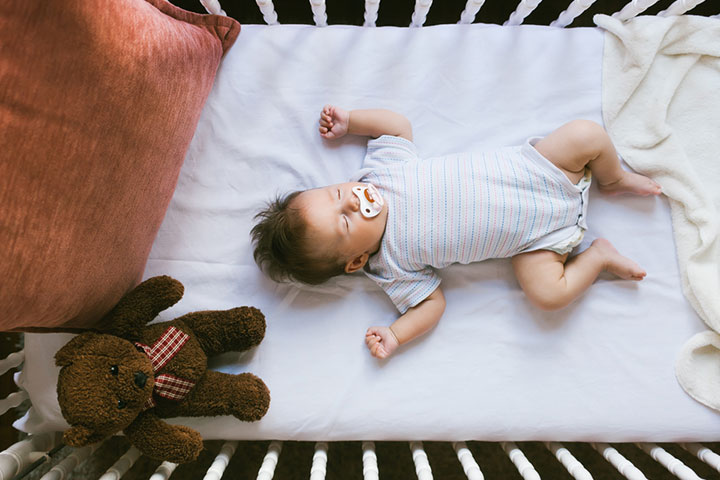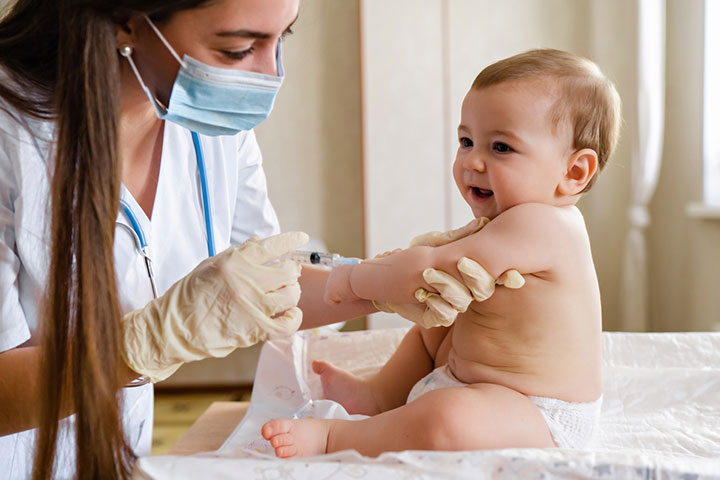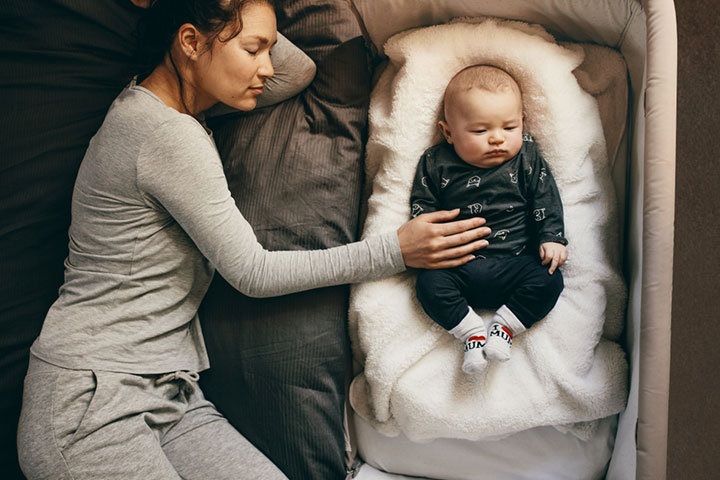Knowing about safe sleeping positions for babies is important in ensuring a safe sleep environment and preventing the risk of sudden infant death syndrome (SIDS). SIDS falls under the category of sudden unexpected death in infancy (SUDIiXSudden unexpected death in infancy (SUDI) is a baby’s sudden death from an unknown cause.) and is majorly linked to the position in which the baby sleeps. Thus, knowing what positions are safe for your baby to sleep in is important to help prevent unexpected situations. Also, knowing a few tips that will help reduce the risk of SIDS helps go a long way (1). One example of such a position of safe sleeping in babies is the supine position, in which the baby, who is less than a year old, is made to sleep on their back. Read on to know more about safe sleeping positions for babies and tips on sleep safety.
The Good And Bad Positions For A Baby To Sleep
It is essential to learn about the safe and unsafe sleeping positions for a baby to deal with the above risks (2).
1. Sleep on back
Healthy babies born full-term should be placed on their backs for naps, short periods of rest, and sleep at night.
- ‘Sleep on the back’ position was found to lessen the risk of SIDS in babies, as it keeps airways open.
- The US National Institute of Child Health and Human Development (NICHDiXEunice Kennedy Shriver National Institute of Child Health and Human Development.) labeled this as the best sleeping position for babies (3).
- Since the American Academy of Pediatrics made the ‘back-to-sleep’ recommendation in 1992, the SIDS rate has dropped more than 50%. The ‘back-to-sleep’ recommendation was later campaigned as ‘safe to sleep’ (4).
Risks Involved In ‘Sleep On Back’ Position
If infants are placed on the back for a long time, it may lead to ‘positional plagiocephalyiXA condition in infants in which certain parts of their heads take an unusually flattened shape and look.,’ a case of flattened or misshapen head and ‘brachycephalyiXAlso known as flat-head syndrome, this disorder is characterized by a flattened region near the rear of the skull.,’ the flattening of the back of the skull. The shape will become normal by the time they turn one year and rarely requires any treatment. Simple repositioning techniques may be employed to avoid such conditions. They include:
- Increasing ‘tummy time’ of the baby when awake
- Making the baby rest on the other side of the head rather than the flat side.
- Cutting down the time spent by babies in carriers or car-seats.
- Getting more ‘cuddle time’.
- Changing the direction of the baby in the crib so that they do not always view the same things, and in one direction always.
2. Sleep on stomach
Several theories discourage parents from making a baby sleep on the stomach because:
- It could put pressure on a baby’s jaw, reducing the airway and restricting breath.
- If the baby sleeps on the stomach, i.e., in the prone position, they may be lying with the face very close to the sheets and breathing the same air.
- The baby may suffocate while sleeping on the stomach if the mattress is very soft.
- The baby may also breathe in microbes present on the mattress.
When Can Babies Sleep On Stomach?
In rare cases, due to a medical condition, doctors may advise parents to make the baby sleep on the stomach rather than the back.
- A few physicians believe that sleeping on the stomach could be good for babies with severe gastroesophageal reflux or certain upper-airway malformations like Pierre Robin Syndrome, which lead to acute airway obstruction episodes. However, no recent study supported or refuted the benefits. Healthcare providers should consider the potential benefits and risks before recommending this position.
- The danger of vomiting was the most important argument for making the baby sleep on its stomach. This is because doctors believed that it would be dangerous if the baby vomits while sleeping on the back. They argued that babies might choke on their vomit, due to lack of enough strength to turn their head. However, babies sleeping on their backs may not have as much difficulty turning their heads and vomiting the contents of the stomach out.
- Also, you may make a baby with colic sleep on the stomach to relieve them of gas. However, do not do it immediately after feeding them. Let there be some gap between the feed and the sleep time.
Talking about the changes in her baby’s sleep position during the night, a mother and ardent blogger who goes by the name ‘The Wandering Pram’ says, “When she was little, it was much simpler; she always slept on her back, and the only variation was whether her head was to the left or right and whether her left or right arm was raised beside her head.
“Since she got mobile, bedtime is a much more wriggly affair. Her favorite sleep position is on her front with her face to one side and her arms cradling her head or tucked into her side… I always start putting her on her back, and sometimes she falls asleep like that, but she often turns before I’ve even left the room. I’m not sure what the sleep experts would say to some of the positions she finds herself in, but I am careful to check her face isn’t covered (i).”
3. Sleep on the side
It is unsafe for babies to sleep on the side because they may end up on the tummy, increasing the risk of SIDS. According to the US Centers for Disease Control and Prevention (CDC), 41% of sudden infant death syndrome cases were recorded in 2020. Dr. Nilong Vyas, a board-certified pediatrician and sleep consultant from New Orleans, Louisiana, says, “If babies are gassy, holding them on their left side when awake is okay to help eliminate the gas. It is unsafe for babies to sleep on their side; however, if they roll to the side, it is safe to keep them there. It is always best to place the baby on their back to sleep.”
In addition to the good and bad sleeping positions, you must also know about the sleeping practices that could lead to a sudden unexpected death in infants.
Related Products
Pampers Lumi Baby Monitor

Sleeping Practices That Could Lead To Sudden Unexpected Death In Infancy (SUDI)
SUDI includes both SIDS and other fatal sleeping accidents. Here are a few practices that could lead to SUDI:
- Making the baby sleep on the stomach or side.
- Putting the baby to sleep on soft surfaces such as mattress, sofa, waterbed, pillow, or lamb’s wool, either with or without a parent around.
- Covering the baby’s head or face with bedding, which may cause accidental suffocation and overheat.
- Smoking during pregnancy or after childbirth.
SIDS can be a significant risk and should be considered when you follow certain steps to ensure that your newborn sleeps safely.
11 Tips For Safe Baby Sleep
For babies who are healthy and under one year of age, back sleeping is the ideal position. Dr. Vyas recommends, “For SIDS prevention, it is ideal for the babies to sleep on their backs, not the side, chest, or stomach. However, if babies transition independently, leaving them in the same position is okay unless there is distress.” However, some extra measures would be helpful to ensure safe sleep for your baby (1).
- Avoid loose bedding: It is advisable to use a firm mattress rather than an overly soft mattress, waterbed, or sofa for your baby. Experts suggest against the usage of bumper pads, pillows, fluffy bedding or stuffed animals around the baby in the crib. In simple words, anything that could cover a baby’s head or face during sleep is not recommended.
- Keep the crib simple: Do not use wedges, quilts, or comforters under an infant in the crib. Let the infant sleep with the feet touching the bottom of the crib so that he can’t wriggle down under the bedding. Using a firm, clean mattress that fits the cot well and tucking in the bedclothes securely can ensure crib safety. In addition, the sides or ends of the crib should be high enough to prevent the baby from climbing out or crawling out.
- Avoid covering the baby’s head: Blankets should be covered only up to the chest of the baby with arms exposed, to avoid the shifting of the blanket onto the head and thereby preventing suffocation. The American Academy of Pediatrics recommends using ‘sleep sack’ or ‘baby sleep bag’ as a type of bedding to keep him warm without covering the head. Sleeping bags with a fitted neck and armholes and no hood are considered the safest. Wrapping a baby in lightweight cotton or muslin also helps in preventing him from rolling onto the tummy during sleep.
- Avoid overheating: Infants should be clothed lightly for sleep. Avoid over-swaddling and check if the baby is not hot to touch.
- Good sleep environment: It is important to maintain a considerably cool sleeping environment with a temperature of around 20oC for the baby.
- Vaccination: An investigation done on diphtheria-tetanus-pertussis immunization and potential SIDS association by the Berlin School of Public Health has concluded that increased DTP immunization coverage is associated with decreased SIDS mortality (5). Current recommendations on timely DTP immunization should be emphasized and followed to prevent not only specific infectious diseases but also potentially SIDS.
- Use a pacifier (at sleep times): The American Academy of Pediatrics considers pacifiers could prevent SIDS. However, do not force the baby if they do not want it or if it falls out of the mouth. If you are breastfeeding, wait until it is well established before beginning to use a pacifier. It usually takes around three to four weeks of age for the baby to get comfortable with breastfeeding.
- Use technology: If you are worried about the baby’s sleeping position, especially when they are in a separate room, use Wi-Fi baby monitors, app-powered thermostats, or small alarms to monitor the sleep position as well as vitals of your baby.
- Avoid use of products that claim to prevent or reduce SIDS. This is crucial as scientifically, there is no known way to prevent SIDS. Safety and efficacy of wedges, infant sleep positioners, or other such products that claim to prevent SIDS are not proven. On the contrary, various incidents have been reported where these products have been associated with injury and death when used in the baby’s sleep area (6).
- Share the same room: Room sharing with your baby may make a convenient setup for breastfeeding and contact. The crib or bassinet in which the newborn sleeps, should be closer to the parents.
- Avoid sharing the bed: Experts suggest that infants ideally should not share the bed with parents, adults, siblings, or other children. Twins or multiples may be made to sleep separately. Avoid co-sleeping with your baby, especially if you or your partner have been drinking, smoking, or taking medications or drugs that could induce deep sleep. Smoking and the use of a substance like drugs or alcohol significantly increase the risk of SIDS and suffocation in babies, if the bed is shared.
In the first few months, you need to be extra careful with your baby and their habits, including their sleeping position. Learning about the right sleeping position for babies holds great importance in ensuring their safety and preventing any unfortunate events such as SIDS. What may seem like a normal harmless position, such as sleeping on the side and the stomach or sleeping on too soft surfaces, can increase the risk of the condition. So consult your doctor to know about the safe sleep guidelines for your baby and follow the precautionary tips to help your baby have a safe and comfortable sleep.
Key Pointers
- Practicing safe sleeping positions is important as they may lower the occurrence of sudden infant death syndrome (SIDS).
- The supine position is considered the ideal sleeping position for babies.
- Babies should not be made to sleep on their sides and stomachs because doing so could increase their risk of SIDS.
- It is important to avoid making the baby sleep on soft surfaces and keep the crib free from objects.
It is of prime importance that your baby sleeps in the correct position. Watch this informative video to learn tips on the right way for your baby to sleep.
